Resource Planning and Management Strategies in Manufacturing Unit
VerifiedAdded on 2023/06/13
|8
|1896
|131
Report
AI Summary
This report delves into resource planning and management within a manufacturing unit, focusing on strategies for costly inventories, buffer stocks of hazardous materials, and obsolescence mitigation. It addresses the security of inventories through organized movement, sourcing, and monitoring of materials, emphasizing the use of Enterprise Resource Planning (ERP) for efficient financial resource management and customer satisfaction. The discussion includes buffer stock schemes, proper storage and disposal of hazardous materials, and recommendations for managing volatile materials and equipment spare parts. Furthermore, the report examines equipment management practices, utilizing the Equipment Management Process Maturity Model (EMPM) and Equipment Control Matrix (ECM) to enhance equipment control, tracking, and maintenance within a large organization undertaking major infrastructure projects.
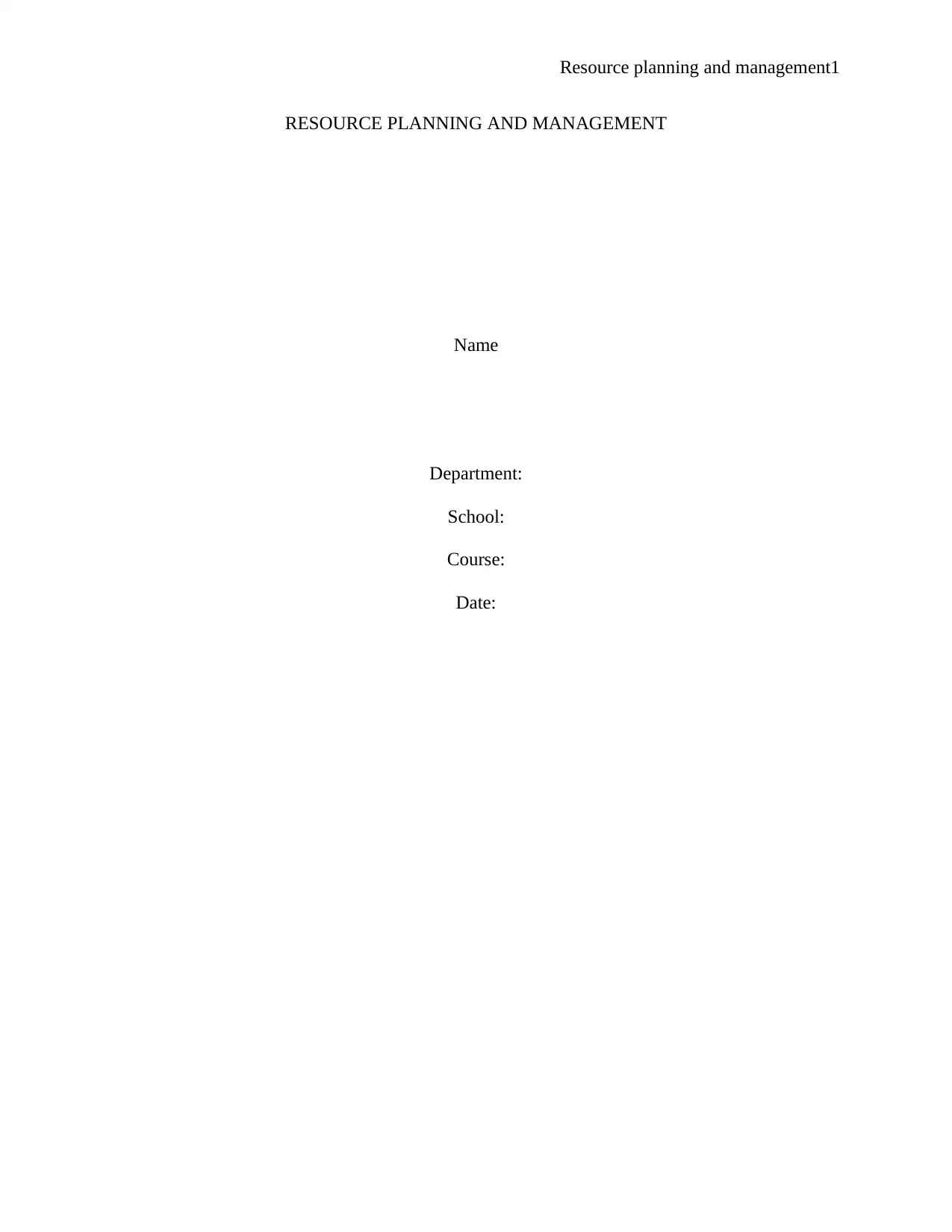
Resource planning and management1
RESOURCE PLANNING AND MANAGEMENT
Name
Department:
School:
Course:
Date:
RESOURCE PLANNING AND MANAGEMENT
Name
Department:
School:
Course:
Date:
Paraphrase This Document
Need a fresh take? Get an instant paraphrase of this document with our AI Paraphraser
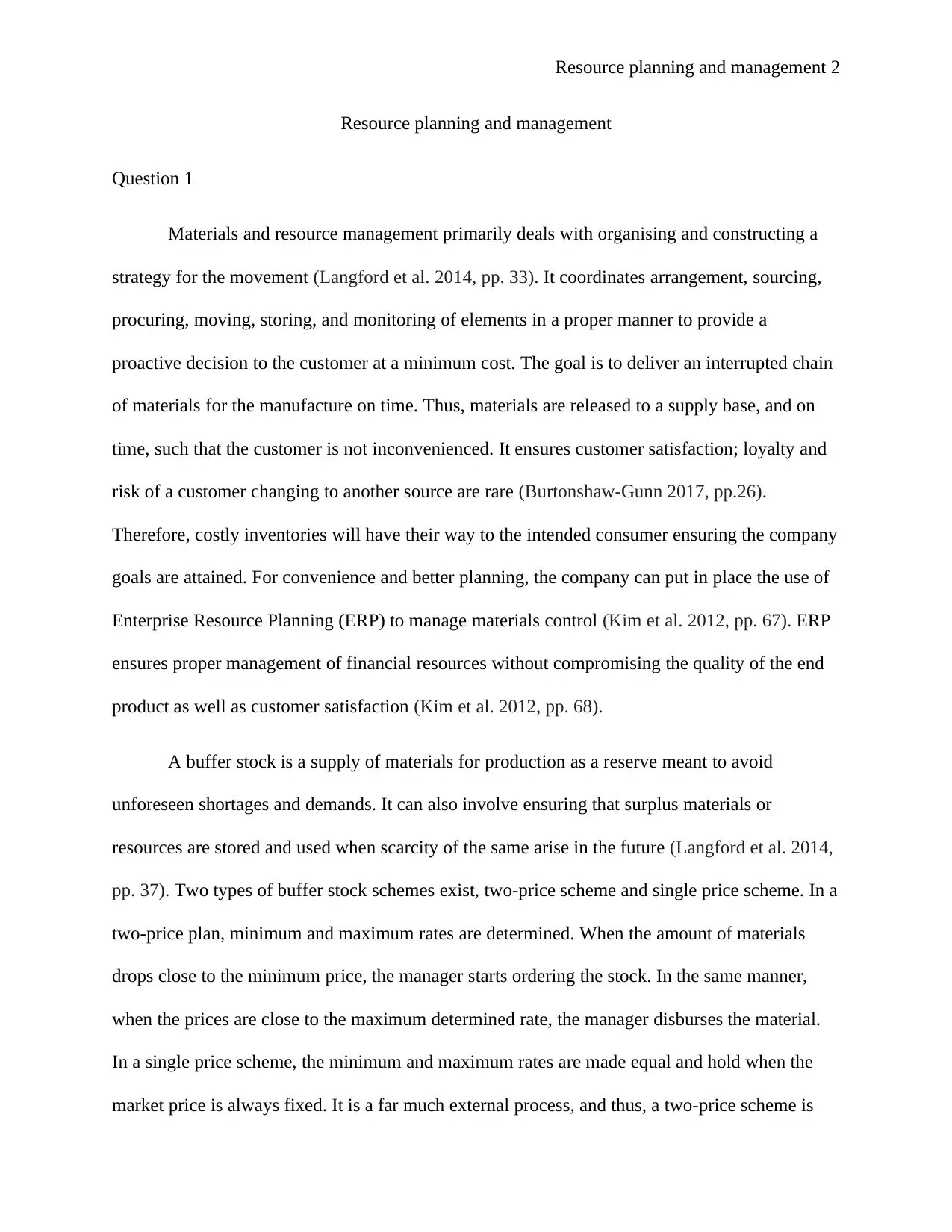
Resource planning and management 2
Resource planning and management
Question 1
Materials and resource management primarily deals with organising and constructing a
strategy for the movement (Langford et al. 2014, pp. 33). It coordinates arrangement, sourcing,
procuring, moving, storing, and monitoring of elements in a proper manner to provide a
proactive decision to the customer at a minimum cost. The goal is to deliver an interrupted chain
of materials for the manufacture on time. Thus, materials are released to a supply base, and on
time, such that the customer is not inconvenienced. It ensures customer satisfaction; loyalty and
risk of a customer changing to another source are rare (Burtonshaw-Gunn 2017, pp.26).
Therefore, costly inventories will have their way to the intended consumer ensuring the company
goals are attained. For convenience and better planning, the company can put in place the use of
Enterprise Resource Planning (ERP) to manage materials control (Kim et al. 2012, pp. 67). ERP
ensures proper management of financial resources without compromising the quality of the end
product as well as customer satisfaction (Kim et al. 2012, pp. 68).
A buffer stock is a supply of materials for production as a reserve meant to avoid
unforeseen shortages and demands. It can also involve ensuring that surplus materials or
resources are stored and used when scarcity of the same arise in the future (Langford et al. 2014,
pp. 37). Two types of buffer stock schemes exist, two-price scheme and single price scheme. In a
two-price plan, minimum and maximum rates are determined. When the amount of materials
drops close to the minimum price, the manager starts ordering the stock. In the same manner,
when the prices are close to the maximum determined rate, the manager disburses the material.
In a single price scheme, the minimum and maximum rates are made equal and hold when the
market price is always fixed. It is a far much external process, and thus, a two-price scheme is
Resource planning and management
Question 1
Materials and resource management primarily deals with organising and constructing a
strategy for the movement (Langford et al. 2014, pp. 33). It coordinates arrangement, sourcing,
procuring, moving, storing, and monitoring of elements in a proper manner to provide a
proactive decision to the customer at a minimum cost. The goal is to deliver an interrupted chain
of materials for the manufacture on time. Thus, materials are released to a supply base, and on
time, such that the customer is not inconvenienced. It ensures customer satisfaction; loyalty and
risk of a customer changing to another source are rare (Burtonshaw-Gunn 2017, pp.26).
Therefore, costly inventories will have their way to the intended consumer ensuring the company
goals are attained. For convenience and better planning, the company can put in place the use of
Enterprise Resource Planning (ERP) to manage materials control (Kim et al. 2012, pp. 67). ERP
ensures proper management of financial resources without compromising the quality of the end
product as well as customer satisfaction (Kim et al. 2012, pp. 68).
A buffer stock is a supply of materials for production as a reserve meant to avoid
unforeseen shortages and demands. It can also involve ensuring that surplus materials or
resources are stored and used when scarcity of the same arise in the future (Langford et al. 2014,
pp. 37). Two types of buffer stock schemes exist, two-price scheme and single price scheme. In a
two-price plan, minimum and maximum rates are determined. When the amount of materials
drops close to the minimum price, the manager starts ordering the stock. In the same manner,
when the prices are close to the maximum determined rate, the manager disburses the material.
In a single price scheme, the minimum and maximum rates are made equal and hold when the
market price is always fixed. It is a far much external process, and thus, a two-price scheme is
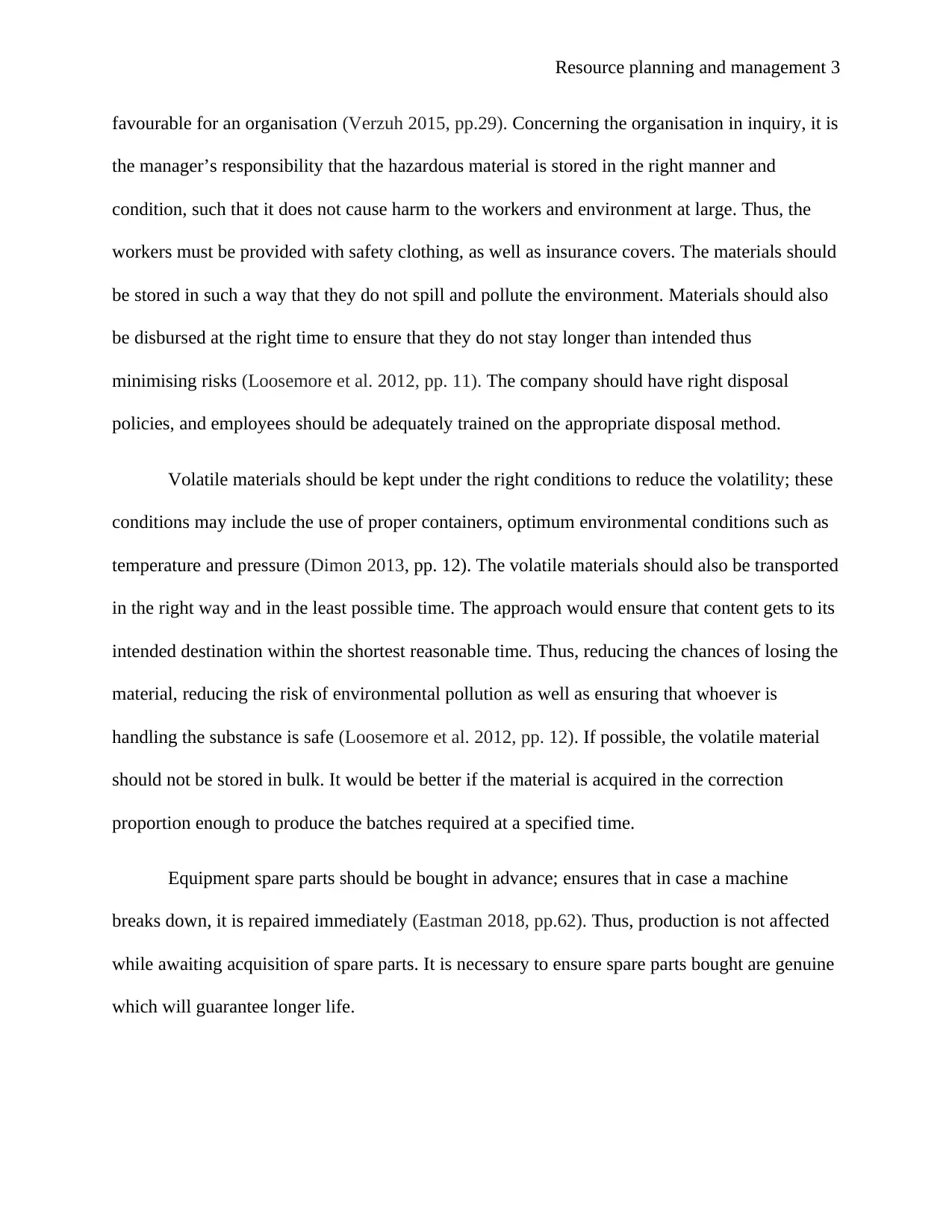
Resource planning and management 3
favourable for an organisation (Verzuh 2015, pp.29). Concerning the organisation in inquiry, it is
the manager’s responsibility that the hazardous material is stored in the right manner and
condition, such that it does not cause harm to the workers and environment at large. Thus, the
workers must be provided with safety clothing, as well as insurance covers. The materials should
be stored in such a way that they do not spill and pollute the environment. Materials should also
be disbursed at the right time to ensure that they do not stay longer than intended thus
minimising risks (Loosemore et al. 2012, pp. 11). The company should have right disposal
policies, and employees should be adequately trained on the appropriate disposal method.
Volatile materials should be kept under the right conditions to reduce the volatility; these
conditions may include the use of proper containers, optimum environmental conditions such as
temperature and pressure (Dimon 2013, pp. 12). The volatile materials should also be transported
in the right way and in the least possible time. The approach would ensure that content gets to its
intended destination within the shortest reasonable time. Thus, reducing the chances of losing the
material, reducing the risk of environmental pollution as well as ensuring that whoever is
handling the substance is safe (Loosemore et al. 2012, pp. 12). If possible, the volatile material
should not be stored in bulk. It would be better if the material is acquired in the correction
proportion enough to produce the batches required at a specified time.
Equipment spare parts should be bought in advance; ensures that in case a machine
breaks down, it is repaired immediately (Eastman 2018, pp.62). Thus, production is not affected
while awaiting acquisition of spare parts. It is necessary to ensure spare parts bought are genuine
which will guarantee longer life.
favourable for an organisation (Verzuh 2015, pp.29). Concerning the organisation in inquiry, it is
the manager’s responsibility that the hazardous material is stored in the right manner and
condition, such that it does not cause harm to the workers and environment at large. Thus, the
workers must be provided with safety clothing, as well as insurance covers. The materials should
be stored in such a way that they do not spill and pollute the environment. Materials should also
be disbursed at the right time to ensure that they do not stay longer than intended thus
minimising risks (Loosemore et al. 2012, pp. 11). The company should have right disposal
policies, and employees should be adequately trained on the appropriate disposal method.
Volatile materials should be kept under the right conditions to reduce the volatility; these
conditions may include the use of proper containers, optimum environmental conditions such as
temperature and pressure (Dimon 2013, pp. 12). The volatile materials should also be transported
in the right way and in the least possible time. The approach would ensure that content gets to its
intended destination within the shortest reasonable time. Thus, reducing the chances of losing the
material, reducing the risk of environmental pollution as well as ensuring that whoever is
handling the substance is safe (Loosemore et al. 2012, pp. 12). If possible, the volatile material
should not be stored in bulk. It would be better if the material is acquired in the correction
proportion enough to produce the batches required at a specified time.
Equipment spare parts should be bought in advance; ensures that in case a machine
breaks down, it is repaired immediately (Eastman 2018, pp.62). Thus, production is not affected
while awaiting acquisition of spare parts. It is necessary to ensure spare parts bought are genuine
which will guarantee longer life.
⊘ This is a preview!⊘
Do you want full access?
Subscribe today to unlock all pages.

Trusted by 1+ million students worldwide
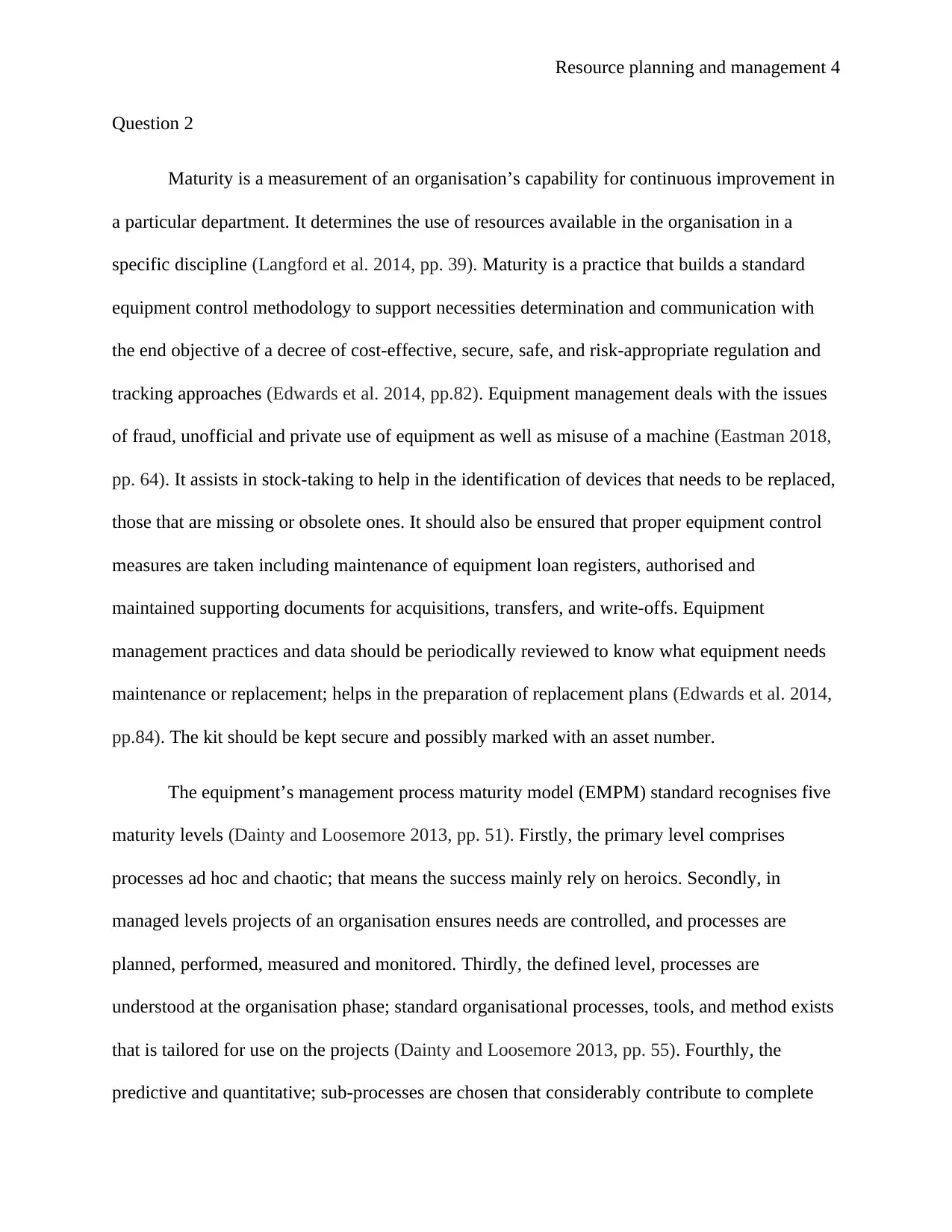
Resource planning and management 4
Question 2
Maturity is a measurement of an organisation’s capability for continuous improvement in
a particular department. It determines the use of resources available in the organisation in a
specific discipline (Langford et al. 2014, pp. 39). Maturity is a practice that builds a standard
equipment control methodology to support necessities determination and communication with
the end objective of a decree of cost-effective, secure, safe, and risk-appropriate regulation and
tracking approaches (Edwards et al. 2014, pp.82). Equipment management deals with the issues
of fraud, unofficial and private use of equipment as well as misuse of a machine (Eastman 2018,
pp. 64). It assists in stock-taking to help in the identification of devices that needs to be replaced,
those that are missing or obsolete ones. It should also be ensured that proper equipment control
measures are taken including maintenance of equipment loan registers, authorised and
maintained supporting documents for acquisitions, transfers, and write-offs. Equipment
management practices and data should be periodically reviewed to know what equipment needs
maintenance or replacement; helps in the preparation of replacement plans (Edwards et al. 2014,
pp.84). The kit should be kept secure and possibly marked with an asset number.
The equipment’s management process maturity model (EMPM) standard recognises five
maturity levels (Dainty and Loosemore 2013, pp. 51). Firstly, the primary level comprises
processes ad hoc and chaotic; that means the success mainly rely on heroics. Secondly, in
managed levels projects of an organisation ensures needs are controlled, and processes are
planned, performed, measured and monitored. Thirdly, the defined level, processes are
understood at the organisation phase; standard organisational processes, tools, and method exists
that is tailored for use on the projects (Dainty and Loosemore 2013, pp. 55). Fourthly, the
predictive and quantitative; sub-processes are chosen that considerably contribute to complete
Question 2
Maturity is a measurement of an organisation’s capability for continuous improvement in
a particular department. It determines the use of resources available in the organisation in a
specific discipline (Langford et al. 2014, pp. 39). Maturity is a practice that builds a standard
equipment control methodology to support necessities determination and communication with
the end objective of a decree of cost-effective, secure, safe, and risk-appropriate regulation and
tracking approaches (Edwards et al. 2014, pp.82). Equipment management deals with the issues
of fraud, unofficial and private use of equipment as well as misuse of a machine (Eastman 2018,
pp. 64). It assists in stock-taking to help in the identification of devices that needs to be replaced,
those that are missing or obsolete ones. It should also be ensured that proper equipment control
measures are taken including maintenance of equipment loan registers, authorised and
maintained supporting documents for acquisitions, transfers, and write-offs. Equipment
management practices and data should be periodically reviewed to know what equipment needs
maintenance or replacement; helps in the preparation of replacement plans (Edwards et al. 2014,
pp.84). The kit should be kept secure and possibly marked with an asset number.
The equipment’s management process maturity model (EMPM) standard recognises five
maturity levels (Dainty and Loosemore 2013, pp. 51). Firstly, the primary level comprises
processes ad hoc and chaotic; that means the success mainly rely on heroics. Secondly, in
managed levels projects of an organisation ensures needs are controlled, and processes are
planned, performed, measured and monitored. Thirdly, the defined level, processes are
understood at the organisation phase; standard organisational processes, tools, and method exists
that is tailored for use on the projects (Dainty and Loosemore 2013, pp. 55). Fourthly, the
predictive and quantitative; sub-processes are chosen that considerably contribute to complete
Paraphrase This Document
Need a fresh take? Get an instant paraphrase of this document with our AI Paraphraser
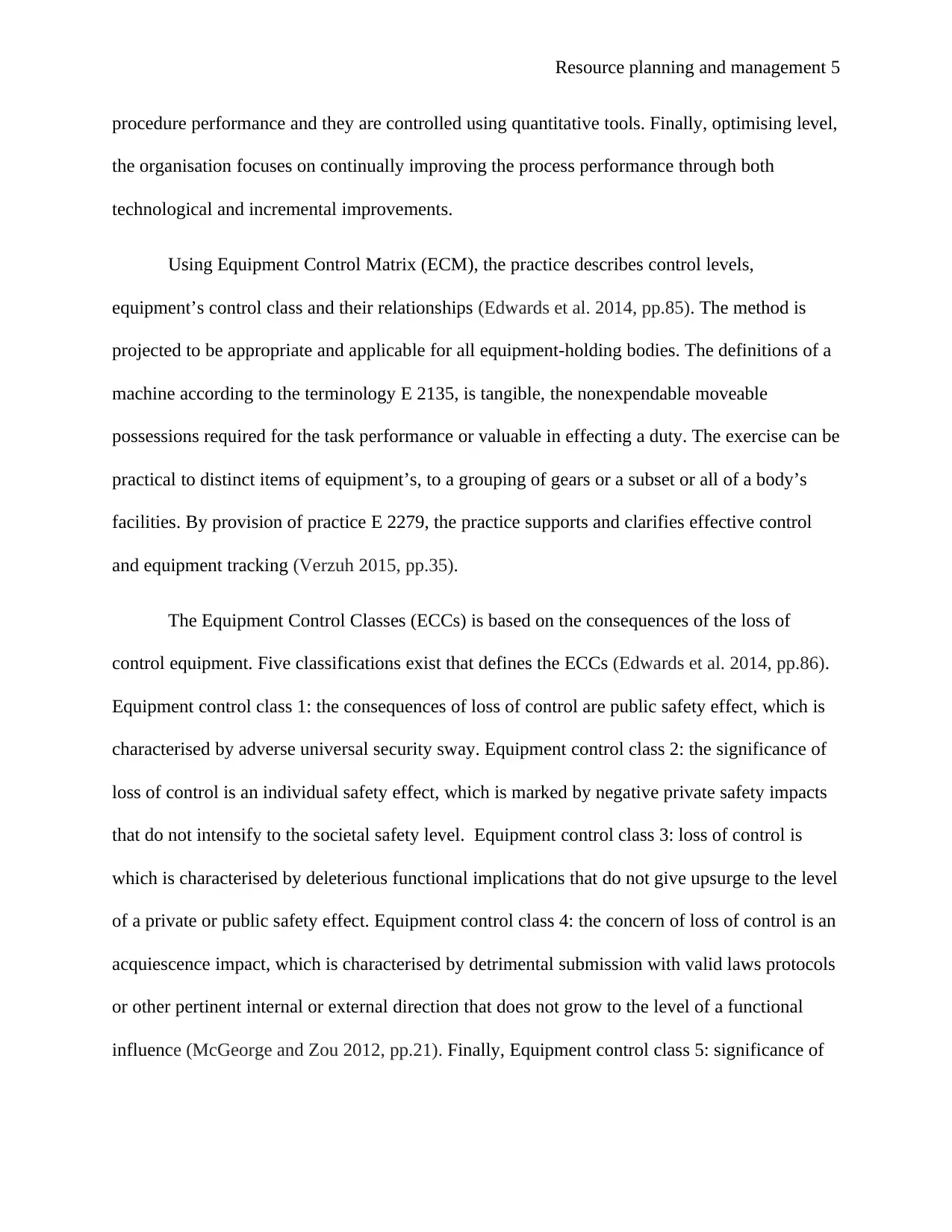
Resource planning and management 5
procedure performance and they are controlled using quantitative tools. Finally, optimising level,
the organisation focuses on continually improving the process performance through both
technological and incremental improvements.
Using Equipment Control Matrix (ECM), the practice describes control levels,
equipment’s control class and their relationships (Edwards et al. 2014, pp.85). The method is
projected to be appropriate and applicable for all equipment-holding bodies. The definitions of a
machine according to the terminology E 2135, is tangible, the nonexpendable moveable
possessions required for the task performance or valuable in effecting a duty. The exercise can be
practical to distinct items of equipment’s, to a grouping of gears or a subset or all of a body’s
facilities. By provision of practice E 2279, the practice supports and clarifies effective control
and equipment tracking (Verzuh 2015, pp.35).
The Equipment Control Classes (ECCs) is based on the consequences of the loss of
control equipment. Five classifications exist that defines the ECCs (Edwards et al. 2014, pp.86).
Equipment control class 1: the consequences of loss of control are public safety effect, which is
characterised by adverse universal security sway. Equipment control class 2: the significance of
loss of control is an individual safety effect, which is marked by negative private safety impacts
that do not intensify to the societal safety level. Equipment control class 3: loss of control is
which is characterised by deleterious functional implications that do not give upsurge to the level
of a private or public safety effect. Equipment control class 4: the concern of loss of control is an
acquiescence impact, which is characterised by detrimental submission with valid laws protocols
or other pertinent internal or external direction that does not grow to the level of a functional
influence (McGeorge and Zou 2012, pp.21). Finally, Equipment control class 5: significance of
procedure performance and they are controlled using quantitative tools. Finally, optimising level,
the organisation focuses on continually improving the process performance through both
technological and incremental improvements.
Using Equipment Control Matrix (ECM), the practice describes control levels,
equipment’s control class and their relationships (Edwards et al. 2014, pp.85). The method is
projected to be appropriate and applicable for all equipment-holding bodies. The definitions of a
machine according to the terminology E 2135, is tangible, the nonexpendable moveable
possessions required for the task performance or valuable in effecting a duty. The exercise can be
practical to distinct items of equipment’s, to a grouping of gears or a subset or all of a body’s
facilities. By provision of practice E 2279, the practice supports and clarifies effective control
and equipment tracking (Verzuh 2015, pp.35).
The Equipment Control Classes (ECCs) is based on the consequences of the loss of
control equipment. Five classifications exist that defines the ECCs (Edwards et al. 2014, pp.86).
Equipment control class 1: the consequences of loss of control are public safety effect, which is
characterised by adverse universal security sway. Equipment control class 2: the significance of
loss of control is an individual safety effect, which is marked by negative private safety impacts
that do not intensify to the societal safety level. Equipment control class 3: loss of control is
which is characterised by deleterious functional implications that do not give upsurge to the level
of a private or public safety effect. Equipment control class 4: the concern of loss of control is an
acquiescence impact, which is characterised by detrimental submission with valid laws protocols
or other pertinent internal or external direction that does not grow to the level of a functional
influence (McGeorge and Zou 2012, pp.21). Finally, Equipment control class 5: significance of
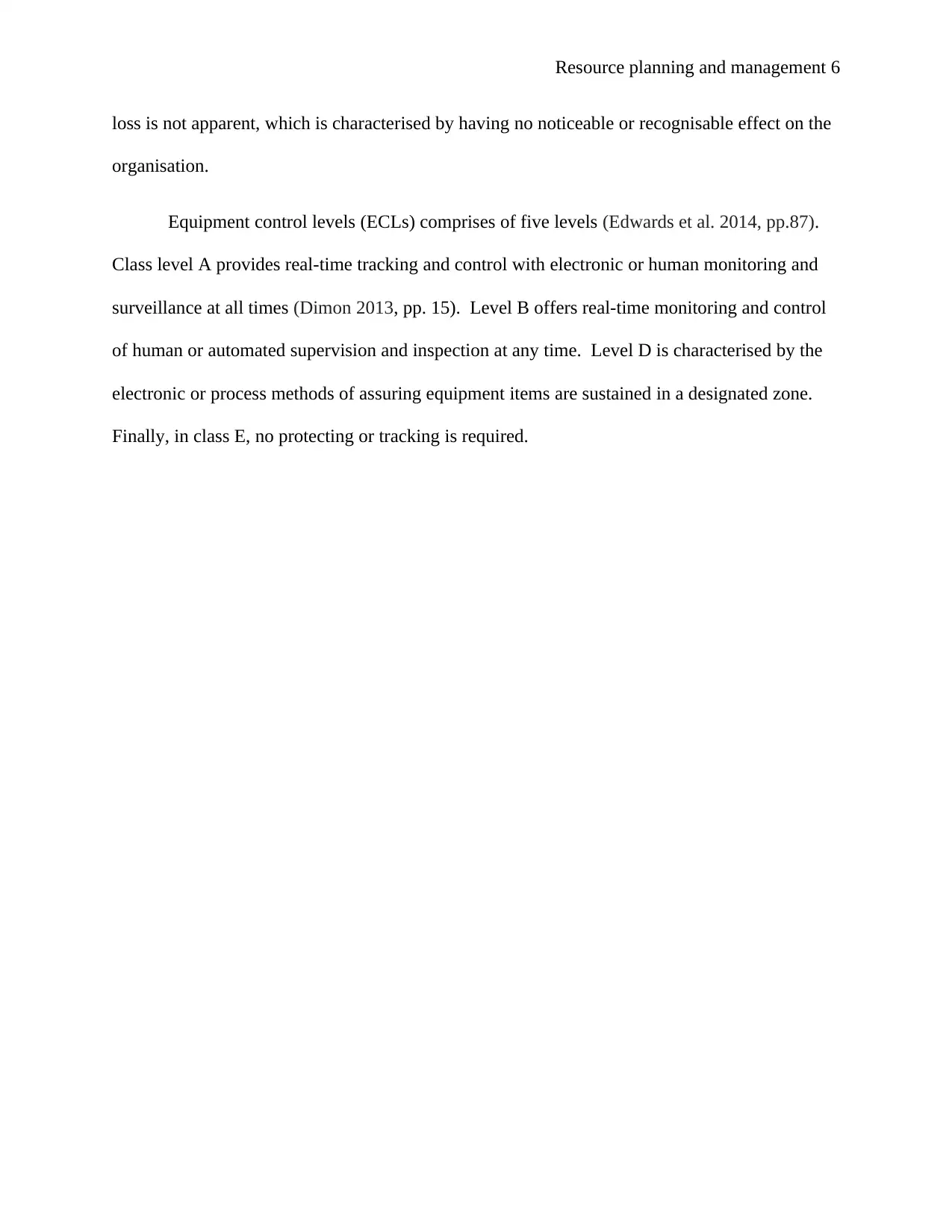
Resource planning and management 6
loss is not apparent, which is characterised by having no noticeable or recognisable effect on the
organisation.
Equipment control levels (ECLs) comprises of five levels (Edwards et al. 2014, pp.87).
Class level A provides real-time tracking and control with electronic or human monitoring and
surveillance at all times (Dimon 2013, pp. 15). Level B offers real-time monitoring and control
of human or automated supervision and inspection at any time. Level D is characterised by the
electronic or process methods of assuring equipment items are sustained in a designated zone.
Finally, in class E, no protecting or tracking is required.
loss is not apparent, which is characterised by having no noticeable or recognisable effect on the
organisation.
Equipment control levels (ECLs) comprises of five levels (Edwards et al. 2014, pp.87).
Class level A provides real-time tracking and control with electronic or human monitoring and
surveillance at all times (Dimon 2013, pp. 15). Level B offers real-time monitoring and control
of human or automated supervision and inspection at any time. Level D is characterised by the
electronic or process methods of assuring equipment items are sustained in a designated zone.
Finally, in class E, no protecting or tracking is required.
⊘ This is a preview!⊘
Do you want full access?
Subscribe today to unlock all pages.

Trusted by 1+ million students worldwide
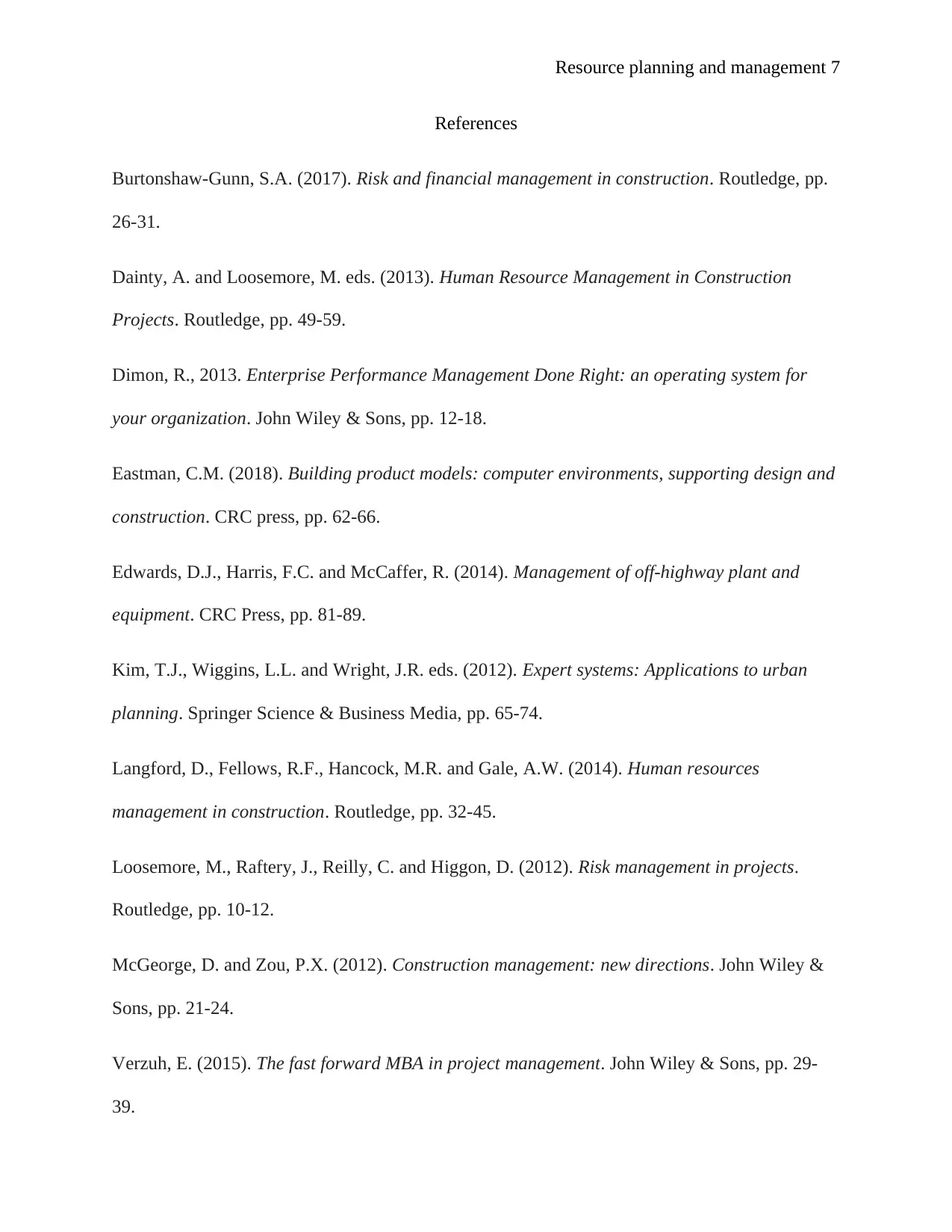
Resource planning and management 7
References
Burtonshaw-Gunn, S.A. (2017). Risk and financial management in construction. Routledge, pp.
26-31.
Dainty, A. and Loosemore, M. eds. (2013). Human Resource Management in Construction
Projects. Routledge, pp. 49-59.
Dimon, R., 2013. Enterprise Performance Management Done Right: an operating system for
your organization. John Wiley & Sons, pp. 12-18.
Eastman, C.M. (2018). Building product models: computer environments, supporting design and
construction. CRC press, pp. 62-66.
Edwards, D.J., Harris, F.C. and McCaffer, R. (2014). Management of off-highway plant and
equipment. CRC Press, pp. 81-89.
Kim, T.J., Wiggins, L.L. and Wright, J.R. eds. (2012). Expert systems: Applications to urban
planning. Springer Science & Business Media, pp. 65-74.
Langford, D., Fellows, R.F., Hancock, M.R. and Gale, A.W. (2014). Human resources
management in construction. Routledge, pp. 32-45.
Loosemore, M., Raftery, J., Reilly, C. and Higgon, D. (2012). Risk management in projects.
Routledge, pp. 10-12.
McGeorge, D. and Zou, P.X. (2012). Construction management: new directions. John Wiley &
Sons, pp. 21-24.
Verzuh, E. (2015). The fast forward MBA in project management. John Wiley & Sons, pp. 29-
39.
References
Burtonshaw-Gunn, S.A. (2017). Risk and financial management in construction. Routledge, pp.
26-31.
Dainty, A. and Loosemore, M. eds. (2013). Human Resource Management in Construction
Projects. Routledge, pp. 49-59.
Dimon, R., 2013. Enterprise Performance Management Done Right: an operating system for
your organization. John Wiley & Sons, pp. 12-18.
Eastman, C.M. (2018). Building product models: computer environments, supporting design and
construction. CRC press, pp. 62-66.
Edwards, D.J., Harris, F.C. and McCaffer, R. (2014). Management of off-highway plant and
equipment. CRC Press, pp. 81-89.
Kim, T.J., Wiggins, L.L. and Wright, J.R. eds. (2012). Expert systems: Applications to urban
planning. Springer Science & Business Media, pp. 65-74.
Langford, D., Fellows, R.F., Hancock, M.R. and Gale, A.W. (2014). Human resources
management in construction. Routledge, pp. 32-45.
Loosemore, M., Raftery, J., Reilly, C. and Higgon, D. (2012). Risk management in projects.
Routledge, pp. 10-12.
McGeorge, D. and Zou, P.X. (2012). Construction management: new directions. John Wiley &
Sons, pp. 21-24.
Verzuh, E. (2015). The fast forward MBA in project management. John Wiley & Sons, pp. 29-
39.
Paraphrase This Document
Need a fresh take? Get an instant paraphrase of this document with our AI Paraphraser
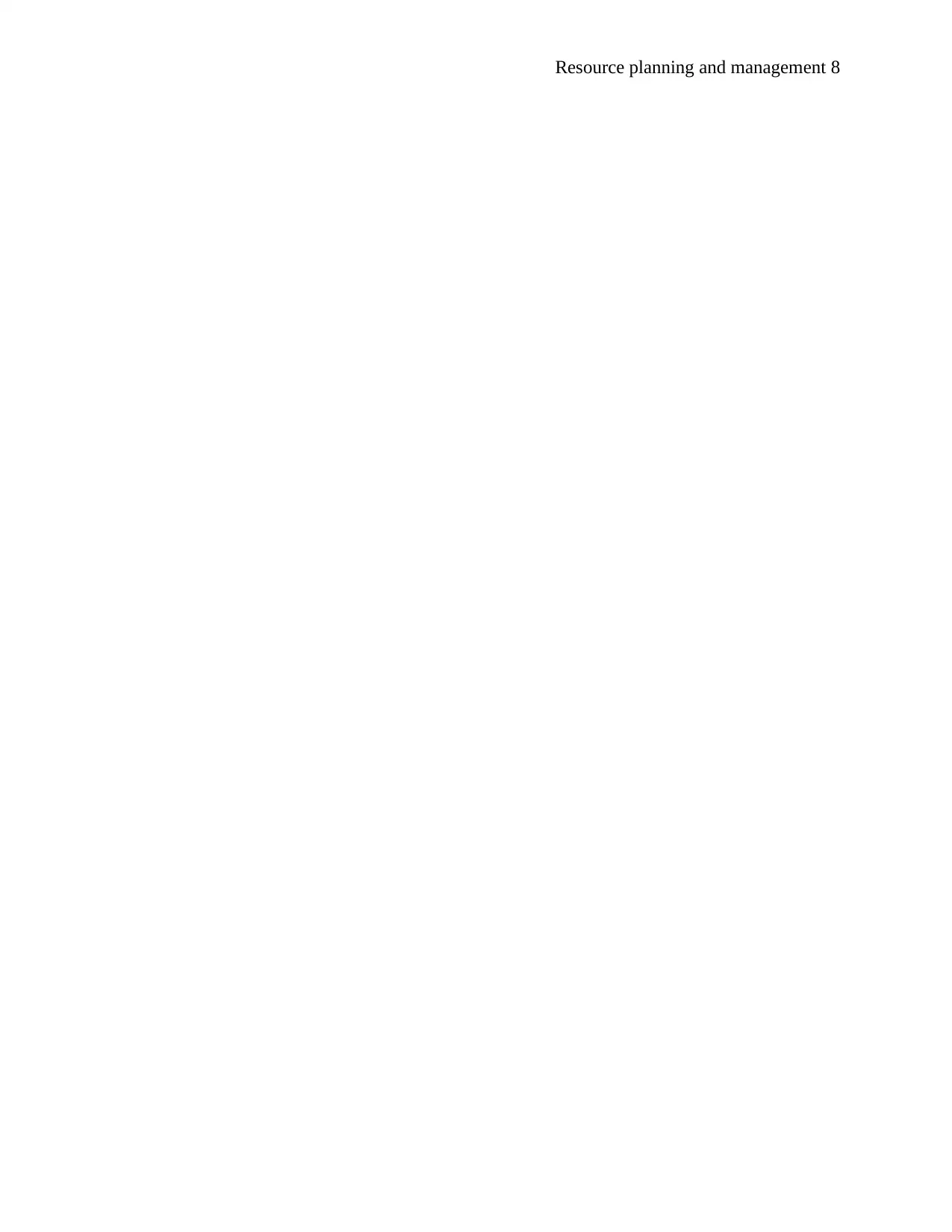
Resource planning and management 8
1 out of 8
Your All-in-One AI-Powered Toolkit for Academic Success.
+13062052269
info@desklib.com
Available 24*7 on WhatsApp / Email
![[object Object]](/_next/static/media/star-bottom.7253800d.svg)
Unlock your academic potential
Copyright © 2020–2025 A2Z Services. All Rights Reserved. Developed and managed by ZUCOL.


